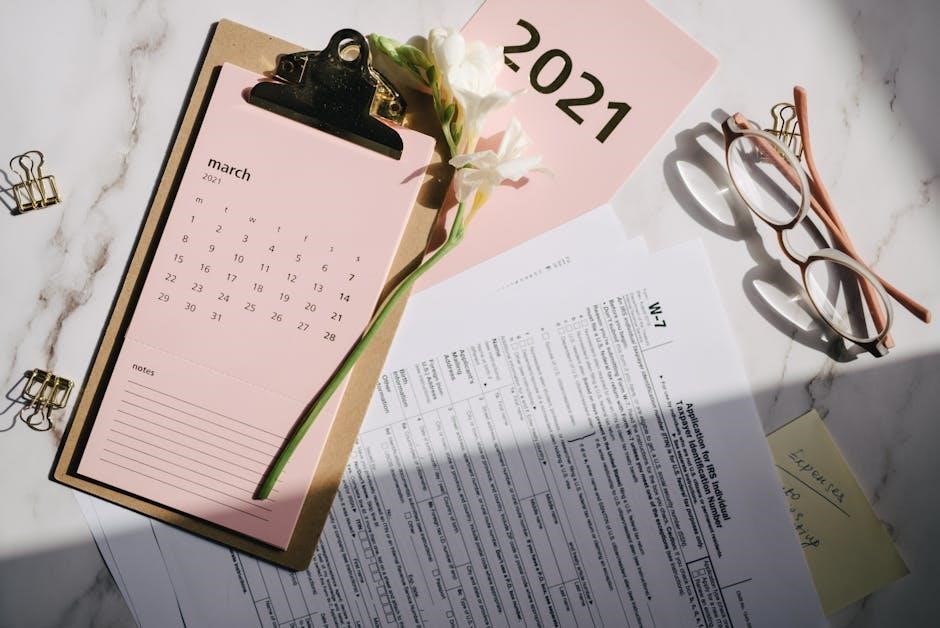Overview of Schedule D (Form 990)
Schedule D (Form 990) is used by nonprofits filing Form 990 to report details on donor-advised funds, conservation easements, art collections, and custodial arrangements, ensuring transparency and compliance.
Purpose and Scope

Schedule D (Form 990) is designed to provide detailed information about specific activities and holdings of tax-exempt organizations. Its primary purpose is to ensure transparency and accountability by reporting on donor-advised funds, conservation easements, art and museum collections, and escrow or custodial arrangements. This schedule is mandatory for organizations that answer “Yes” to certain questions in Part IV of Form 990, ensuring compliance with IRS regulations.
The scope of Schedule D extends to requiring organizations to disclose financial and operational details related to these specific areas. It helps the IRS and the public understand how resources are managed and ensures adherence to tax-exempt standards. Accurate and complete reporting is essential to maintain compliance and public trust.
Key Components and Structure
Schedule D (Form 990) is divided into multiple parts, each focusing on specific areas of reporting. Part I covers donor-advised funds, requiring details on contributions, grants, and administrative fees. Part II pertains to conservation easements, documenting the purpose, monitoring, and enforcement of these agreements. Part III is dedicated to art and museum collections, ensuring proper valuation and public access. Part IV addresses escrow or custodial arrangements, outlining the terms and purposes of such holdings. The schedule also includes sections for supplementary information and explanations. Its structured format ensures clarity and comprehensiveness, making it easier for organizations to report accurately and for the IRS to review effectively. Understanding its components is essential for proper compliance and transparency.

When to Complete Schedule D
Organizations must complete Schedule D if they answer “Yes” on Form 990, Part IV, line 6, or manage donor-advised funds, conservation easements, or certain assets requiring detailed reporting.
Thresholds and Filing Requirements
Organizations must complete Schedule D if they answer “Yes” to specific questions on Form 990, particularly Part IV, line 6. This includes managing donor-advised funds, holding conservation easements, or maintaining art and museum collections. Additionally, entities involved in escrow or custodial arrangements must file Schedule D. There are no specific financial thresholds for filing; however, the presence of these activities triggers the requirement. Failure to submit Schedule D when required can result in penalties and delays in processing the organization’s tax-exempt status. It is essential to review the IRS guidelines to ensure compliance with all filing obligations.
Specific Scenarios Requiring Schedule D
Organizations must file Schedule D in specific scenarios, such as managing donor-advised funds, acquiring or holding conservation easements, or maintaining art and museum collections. Additionally, entities involved in escrow or custodial arrangements must complete Schedule D. This includes reporting details about donor-advised funds, such as contributions and distributions, and providing information on conservation easements, like the nature of the easement and its valuation. For art and museum collections, the organization must disclose the items held and their estimated value. Each part of Schedule D corresponds to these specific activities, ensuring transparency and compliance with IRS requirements. Accurate reporting in these scenarios is essential to avoid penalties and maintain tax-exempt status.

Understanding Parts of Schedule D
- Part I: Reports donor-advised funds, including contributions and distributions.
- Part II: Details conservation easements, such as their nature and valuation.
- Part III: Documents art and museum collections, focusing on held items.
- Part IV: Covers escrow or custodial arrangements and related transactions.

Part I: Donor-Advised Funds
Part I of Schedule D focuses on reporting donor-advised funds (DAFs), which are accounts held by a nonprofit where the donor retains advisory privileges. Organizations must disclose the number of DAFs, total contributions received, and distributions made during the tax year. Additionally, they must report the total assets held in these funds at year-end. This section ensures transparency and accountability, as nonprofits managing DAFs must comply with specific IRS regulations. Accurate reporting is crucial to maintain compliance and avoid potential penalties. This part also requires details on compliance with applicable laws, ensuring the nonprofit operates within regulatory guidelines. Proper documentation here helps maintain public trust and satisfies IRS oversight requirements.
Part II: Conservation Easements
Part II of Schedule D requires reporting on conservation easements held by the organization. Nonprofits must disclose the number of easements, their purpose, and whether they monitor compliance with easement terms. Additionally, they must report any significant modifications to existing easements during the tax year. This section ensures that organizations comply with IRS regulations regarding the use and management of conservation easements. Proper reporting is essential to maintain transparency and satisfy IRS oversight. The information provided helps verify that the easements align with the organization’s exempt purpose and meet legal requirements, fostering accountability and public trust in the organization’s stewardship of these resources.
Part III: Art and Museum Collections
Part III of Schedule D focuses on reporting information related to art and museum collections. Organizations must disclose the number of items in their collections and provide an estimate of their total value. Additionally, they must indicate whether these items are preserved for public display or education. This section also requires reporting on any significant changes to the collection, such as acquisitions or sales, and whether the items are accessible to the public. Proper documentation and compliance with IRS guidelines are essential to ensure transparency and maintain tax-exempt status. This reporting helps verify that the collections align with the organization’s charitable mission and serves the public interest.
Part IV: Escrow or Custodial Arrangements
Part IV of Schedule D requires organizations to report details about escrow or custodial arrangements involving their assets. This includes describing the type of assets held, their purpose, and the terms of the arrangement. Organizations must also disclose the names of entities involved and any changes to these arrangements during the tax year. Additionally, they must indicate whether the assets are restricted or subject to specific conditions; Proper documentation and accurate reporting are crucial to ensure compliance with IRS regulations. This section helps the IRS verify that the organization’s financial dealings are transparent and align with its exempt purpose, maintaining public trust and accountability.

Instructions for Completing Schedule D
Review each question carefully, enter numbers from Form 1096 as required, check applicable boxes, and ensure all information is accurate to maintain compliance with IRS regulations.
General Filing Tips
Review each question carefully to ensure accurate and complete responses. Enter the number reported in box 3 of Form 1096 where required. Use -0- in columns (D), (E), and (F) if no compensation was paid. List all current key employees, if any, and refer to the instructions for guidance. Ensure all information pertains to the tax year being reported. Double-check for any applicable boxes that need to be marked. Utilize IRS guidelines and resources for clarification. Accurately report details on donor-advised funds, conservation easements, and other specified categories. Ensure transparency and compliance by following the instructions closely.
Common Mistakes to Avoid
Avoid entering incorrect numbers from Form 1096 or failing to use -0- in columns (D), (E), and (F) when no compensation is paid. Ensure all current key employees are listed and properly categorized. Do not overlook checking applicable boxes in Part VII or neglect to review Schedule O for relevant information. Failing to accurately report donor-advised funds, conservation easements, or art collections can lead to errors. Ensure all details align with the tax year being reported. Avoid ignoring instructions for specific parts, such as Parts VI, VII, VIII, IX, or X, when applicable. Double-check entries for consistency and accuracy before submission to prevent costly corrections.
Additional Resources and References
Visit irs.gov/Form990 for detailed instructions and the latest updates. Expert tips and tools, like TaxZerone, can simplify filing and ensure compliance with Schedule D requirements.
IRS Guidelines and Publications
The IRS provides comprehensive guidelines for completing Schedule D in the Instructions for Form 990. These publications detail reporting requirements for donor-advised funds, conservation easements, and art collections. They also outline thresholds for filing and specific scenarios that necessitate Schedule D. Additionally, the IRS offers resources on Form 1096 and Schedule O, which are critical for accurate reporting. For the latest updates, visit the IRS website. Ensure compliance by referencing these official guidelines, which are regularly updated to reflect current tax laws and regulatory changes.

Expert Tips and Tools
Consult tax professionals to navigate complex reporting requirements, especially for conservation easements and art collections. Utilize tax software like TaxZerone for streamlined filing. Attend webinars for in-depth guidance and access tools like IRS Instructions for clarity. Ensure accuracy by cross-referencing data with Form 1096 and Schedule O. Regularly check the IRS website for updates and resources. These tools and tips help ensure compliance and simplify the process of completing Schedule D accurately and efficiently.
